Study on Elastoplastic Damage Coupling of Reservoir Mudstone Considering Permeability Change
Abstract
:1. Introduction
2. Conventional Triaxial Test of Mudstone
2.1. Lithology and Test Scheme
2.2. Conventional Triaxial Compression Test
2.3. Damage Evolution
3. Elastoplastic Damage Coupling Mechanical Model
3.1. Elastoplastic Damage Coupling
3.2. Construction of the Mechanical Model
3.3. Realization of the Mechanical Model
4. Simulation Verification of the Model
4.1. Mechanical Model Parameters
4.2. Verification of the Constitutive Equation
5. Simulation Analysis of Seepage–Stress Coupling
5.1. Permeability Evolution Model
5.2. Numerical Simulation of Seepage–Stress Coupling
6. Conclusions
Author Contributions
Funding
Data Availability Statement
Acknowledgments
Conflicts of Interest
References
- Corkuma, A.G.; Martinb, C.D. The mechanical behaviour of weak mudstone (Opalinus Clay) at low stresses. Int. J. Rock Mech. Min. 2007, 44, 196–209. [Google Scholar] [CrossRef]
- Nooraiepour, M.; Haile, B.G.; Hellevang, H. Compaction and mechanical strength of Middle Miocene mudstones in the Norwegian North Sea-The major seal for the Skade CO2 storage reservoir. Int. J. Greenh. Gas Control 2017, 67, 49–59. [Google Scholar] [CrossRef]
- Wang, Q.; Hu, X.L.; Xu, C.; Zhou, C.; He, C.C.; Ying, C.Y. Time-dependent behavior of saturated silty mudstone under different confining pressures. Bull. Eng. Geol. Environ. 2020, 79, 2621–2634. [Google Scholar] [CrossRef]
- Chen, Z.F.; Li, X.Y.; Wang, W.; Lu, K.Q.; Zhu, W.P. Theoretical analysis of casing collapse in locally expansive mudstone. J. Pet. Sci. Eng. 2021, 203, 108643. [Google Scholar] [CrossRef]
- Chen, M.; Zang, C.W.; Ding, Z.W.; Zhou, G.L.; Jiang, B.Y.; Zhang, G.C.; Zhang, C.P. Effects of confining pressure on deformation failure behavior of jointed rock. J. Cent. South Univ. 2022, 29, 1305–1319. [Google Scholar] [CrossRef]
- Conil, N.; Djeran-Maigre, I.; Cabrillac, R.; Su, K. Thermodynamics modelling of plasticity and damage of argillite. CR Mec. 2004, 332, 841–848. [Google Scholar] [CrossRef]
- Zhou, C.Y.; Zhu, F.X. An elasto-plastic damage constitutive model with double yield surfaces for saturated soft rock. Int. J. Rock Mech. Min. 2010, 47, 385–395. [Google Scholar] [CrossRef]
- Zhou, X.P. Dynamic damage constitutive relation of mesoscopic heterogenous brittle rock under rotation of principal stress axes. Theor. Appl. Fract. Mech. 2010, 54, 110–116. [Google Scholar] [CrossRef]
- Zhao, G.M.; Xie, L.X.; Meng, X.R. A damage-based constitutive model for rock under impacting load. Int. J. Min. Sci. Technol. 2014, 24, 505–511. [Google Scholar] [CrossRef]
- Unteregger, D.; Fuchs, B.; Hofstetter, G. A damage plasticity model for different types of intact rock. Int. J. Rock Mech. Min. 2015, 80, 402–411. [Google Scholar] [CrossRef]
- Liu, Y.; Dai, F. A damage constitutive model for intermittent jointed rocks under cyclic uniaxial compressio. Int. J. Rock Mech. Min. 2018, 103, 289–301. [Google Scholar] [CrossRef]
- Wu, G.J.; Chen, W.Z.; Rong, C.; Jia, S.P.; Dai, Y.H. Elastoplastic damage evolution constitutive model of saturated rock with respect to volumetric strain in rock and its engineering application. Tunn. Undergr. Space Technol. 2020, 97, 103284. [Google Scholar] [CrossRef]
- Zhang, X.; Lin, H.; Wang, Y.X.; Zhao, Y.L. Creep damage model of rock mass under multi-level creep load based on spatio-temporal evolution of deformation modulus. Arch. Civ. Mech. Eng. 2021, 21, 71. [Google Scholar] [CrossRef]
- Wu, L.Y.; Wang, Z.F.; Ma, D.; Zhang, J.W.; Wu, G.M.; Wen, S.; Zha, M.L.; Wu, L.Z. A Continuous Damage Statistical Constitutive Model for Sandstone and Mudstone Based on Triaxial Compression Tests. Rock Mech. Rock Eng. 2022, 55, 4963–4978. [Google Scholar] [CrossRef]
- Monfared, M.; Sulem, J.; Delage, P.; Mohajerani, M. A laboratory investigation on thermal properties of the opalinus claystone. Rock Mech. Rock Eng. 2011, 44, 735–747. [Google Scholar] [CrossRef]
- Ge, Z.L.; Sun, Q.; Li, W.P. Temperature and Pressure Effect on Permeability of Chinese Sandstone: A Review. Acta Geodyn. Geomater. 2018, 15, 289–296. [Google Scholar] [CrossRef] [Green Version]
- Chen, L.; Wang, C.P.; Liu, J.F.; Liu, Y.M.; Liu, J.; Su, R.; Wang, J. A damage-mechanism-based creep model considering temperature effect in granit. Mech. Res. Commun. 2014, 5, 76–82. [Google Scholar] [CrossRef]
- Wang, X.L.; Zhang, H.J.; Qian, L.; Yao, T.Z.; Mo, Z.G.; He, J.H.; Zhang, R. Nonlinear statistical damage constitutive model of granite based on the energy dissipation ratio. Sci. Rep. 2022, 12, 5460. [Google Scholar] [CrossRef]
- Wang, J.B.; Zhang, Q.; Song, Z.P.; Zhang, Y.W.; Liu, X.R. Mechanical properties and damage constitutive model for uniaxial compression of salt rock at different loading rates. Int. J. Damage Mech. 2021, 30, 739–763. [Google Scholar] [CrossRef]
- He, M.M.; Li, N.; Zhu, C.H.; Chen, Y.S.; Wu, H. Experimental investigation and damage modeling of salt rock subjected to fatigue loading. Int. J. Rock Mech. Min. 2019, 114, 17–23. [Google Scholar] [CrossRef]
- Yu, S.W.; Feng, X.Q. Damage Mechanics; Tsinghua University Press: Beijing, China, 1997. [Google Scholar]
- Zhou, J.W.; Yang, X.G.; Fu, W.X.; Xu, J.; Li, H.T.; Zhou, H.W.; Liu, J. Experimental test and fracture damage mechanical characteristics of brittle rock under uniaxial cyclic loading and unloading conditions. Chin. J. Rock Mech. Eng. 2010, 29, 1172–1183. (In Chinese) [Google Scholar]
- Chen, L.; Liu, J.F.; Wang, C.P.; Wang, X.Y.; Su, R.; Wang, J.F.; Shao, J. Elastoplastic damage model of Beishan deep granite. Chin. J. Rock Mech. Eng. 2013, 32, 289–298. (In Chinese) [Google Scholar]
- Qi, H.; Li, Y.G.; Lu, X.L. A practical elastic plastic damage constitutive model Based on energy. Eng. Mech. 2013, 30, 172–180. (In Chinese) [Google Scholar]
- Li, Z.; Liu, S.G.; Yu, J.X.; Hu, M.M. Study on Mechanical Model of Chlorite Schist Considering Elastoplastic Damage Coupling. Chin. J. Undergr. Space Eng. 2017, 13, 101–107. (In Chinese) [Google Scholar]
- Pensee, V.; Kondo, D.; Dormieux, L. Micromechanical Analysis of Anisotropic Damage in Brittle Materials. J. Eng. Mech. 2007, 128, 889–897. [Google Scholar] [CrossRef]
- Shao, J.F.; Jia, Y.; Kondo, D.; Chiarelli, A.S. A coupled elastoplastic damage model for semi-brittle materials and extension to unsaturated conditions. Mech Mater. 2006, 38, 218–232. [Google Scholar] [CrossRef]
- Shao, J.F.; Zhu, Q.Z.; Su, K. Modeling of creep in rock materials in terms of material degradation. Comput. Geotech. 2003, 30, 549–555. [Google Scholar] [CrossRef]
- Zhang, Y.; Zhang, X.D.; Shao, J.F.; Jia, Y.; Wang, Y.L. Elastoplastic modelling the creep behaviour of cataclastic rock under multi-stage deviatoric stress. Eur. J. Environ. Civ. Eng. 2018, 22, 650–665. [Google Scholar] [CrossRef]
- Yu, H.D. Study on Long Term Hydro-Mechanical Coupled Behavior of Belgium Boom Clay; Institute of Rock and Soil Mechanics, Chinese Academy of Sciences: Wuhan, China, 2010. (In Chinese) [Google Scholar]
- Zhang, L.W. A Research of Boom Clay Elastic-Plastic Constitutive Model Considering the Coupling Effects of Stress and Seepage; School of Urban Construction, Yangtze University: Hubei, China, 2014. (In Chinese) [Google Scholar]
- Jia, S.P.; Gao, M.; Gong, J.; Chen, W.Z.; Yu, H.D. Permeability Evolution Model for Clay Stone with High Porosity and Low Permeability in Coupled Hydro-mechanical Condition. J. Basic Sci. Eng. 2015, 23, 1221–1234. (In Chinese) [Google Scholar]
- Yang, H.; Jia, Y.; Xie, S.Y.; Shao, J.F. An Experimental and Numerical Investigation of the Mechanical Behaviour of a Concrete and of its Permeability Under Deviatoric Loading. Transp. Porous Med. 2014, 102, 427–454. [Google Scholar] [CrossRef]
- Jia, S.P.; Gao, M.; Yu, H.D.; Gong, J. A Coupled Damage-Permeability Model of Clay Stone with High Porosity and Low Permeability and Its Numerical Implementation. J. Cent. South Univ. Sci. Technol. 2016, 47, 558–568. (In Chinese) [Google Scholar]

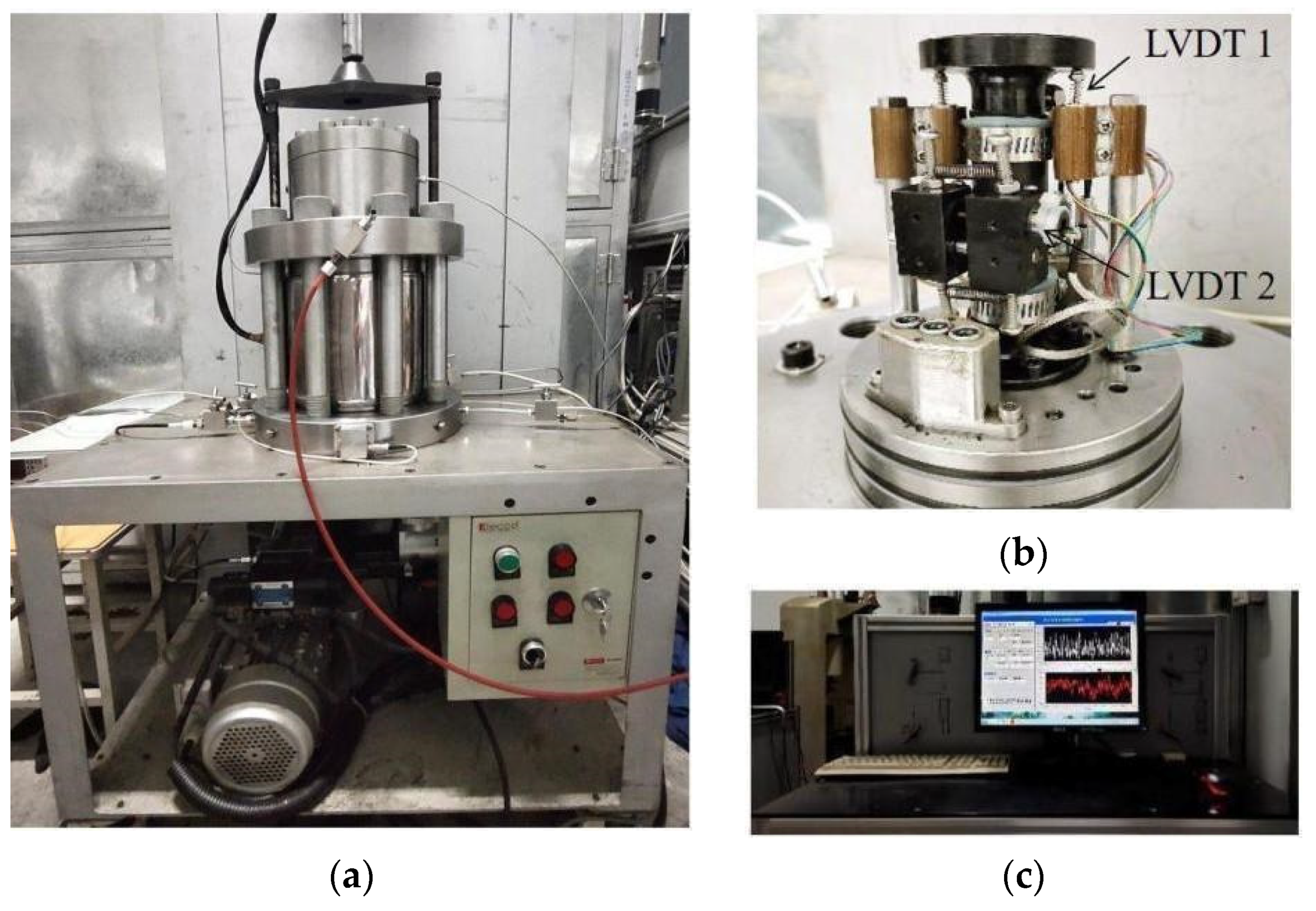
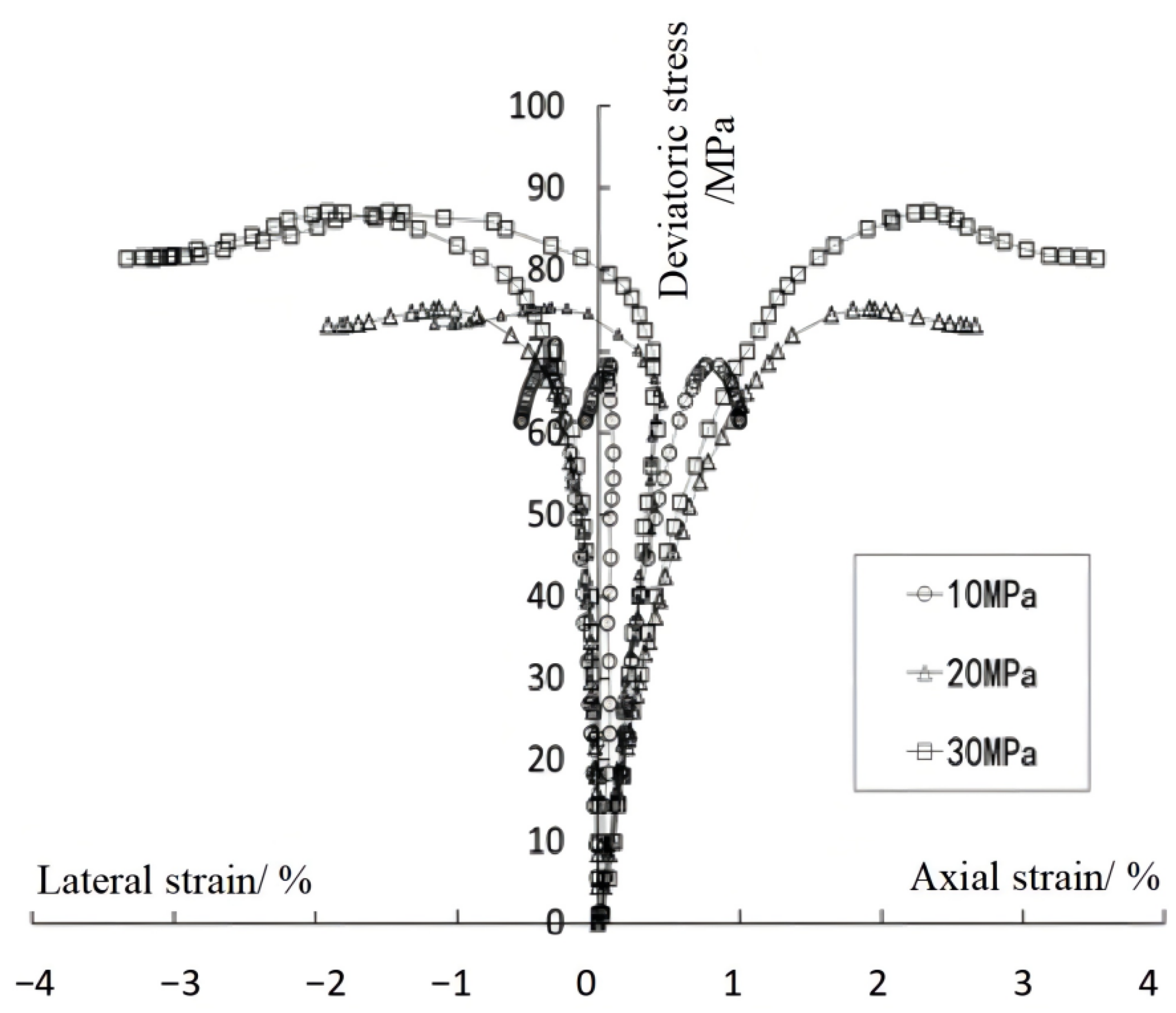


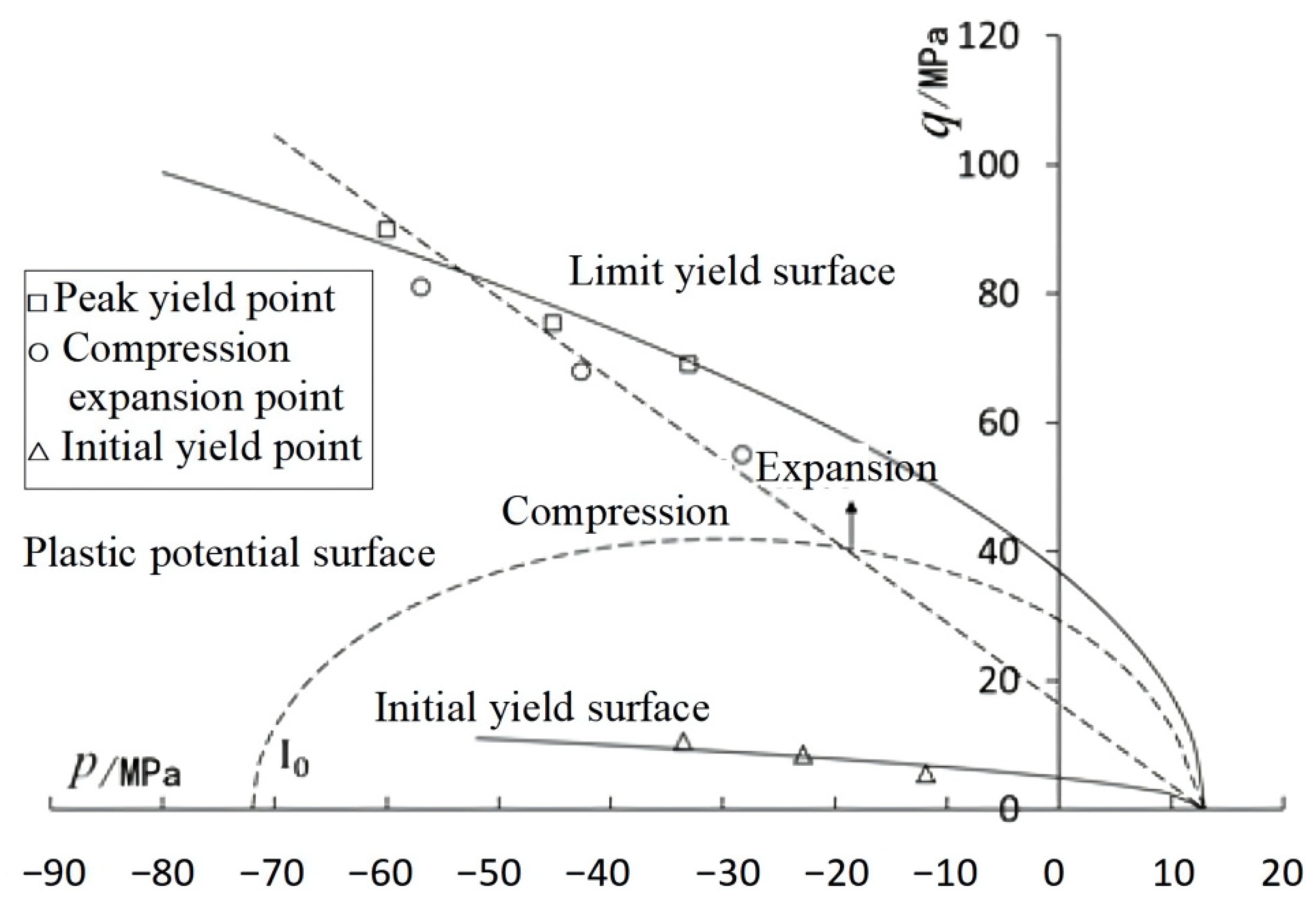
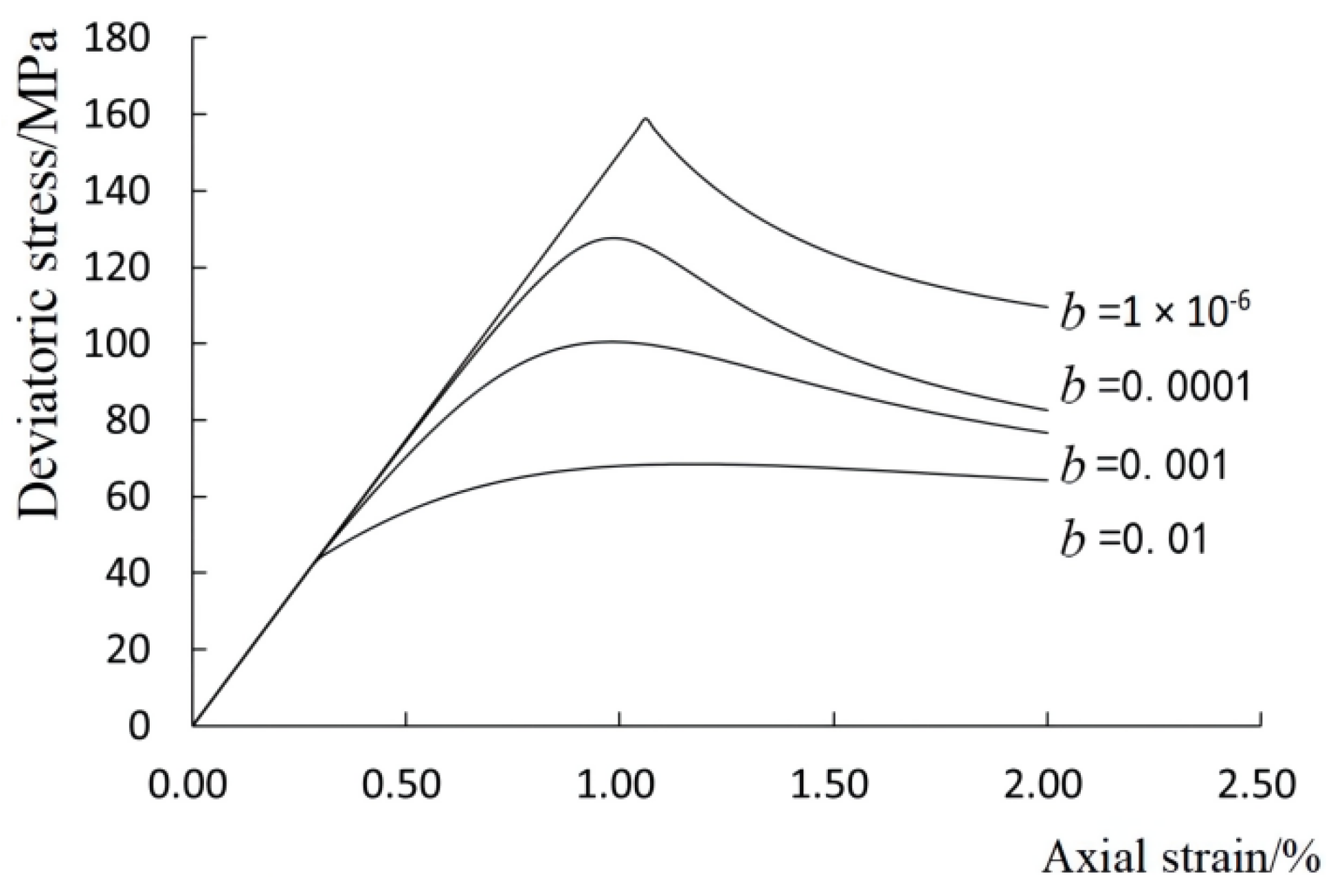


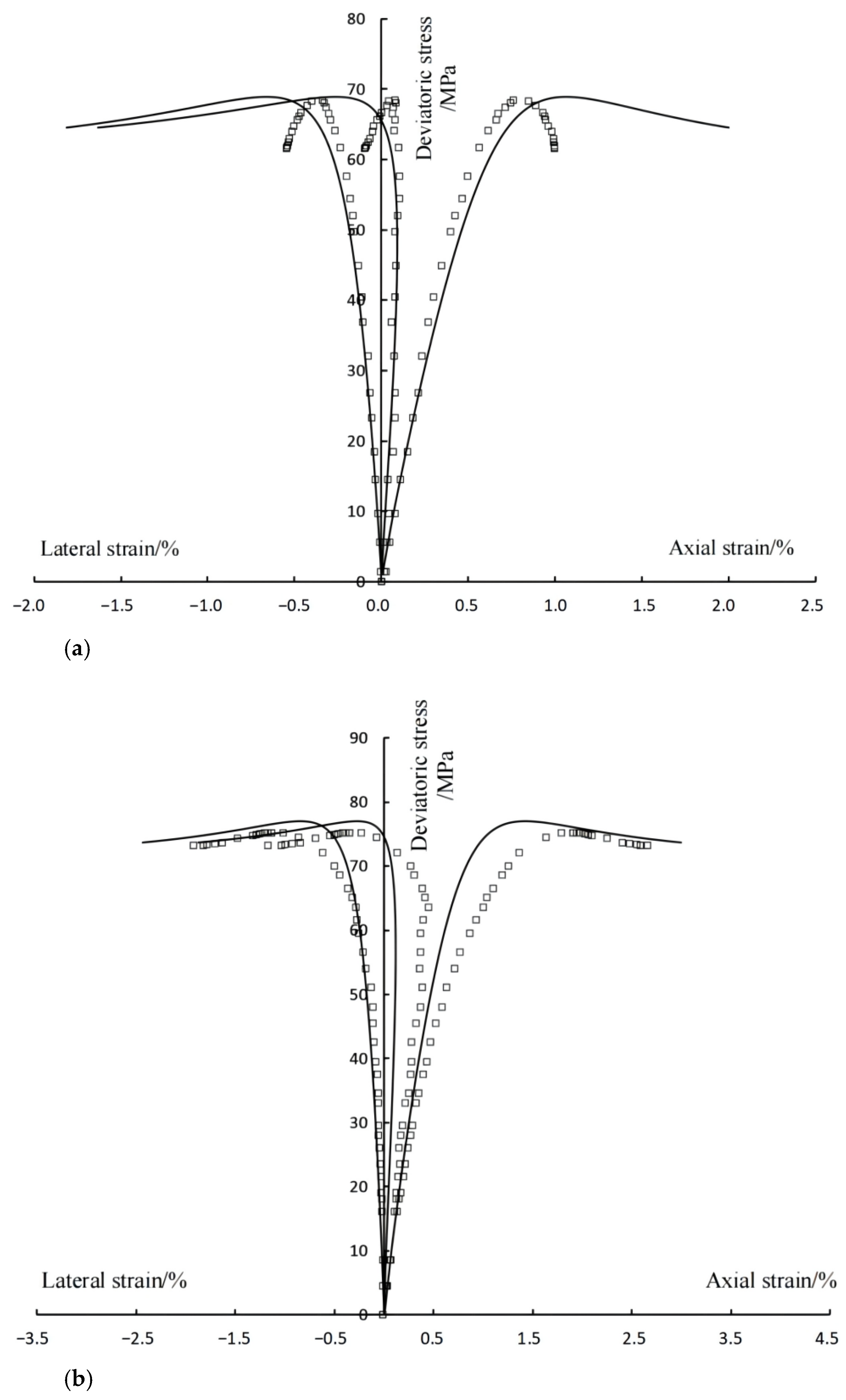
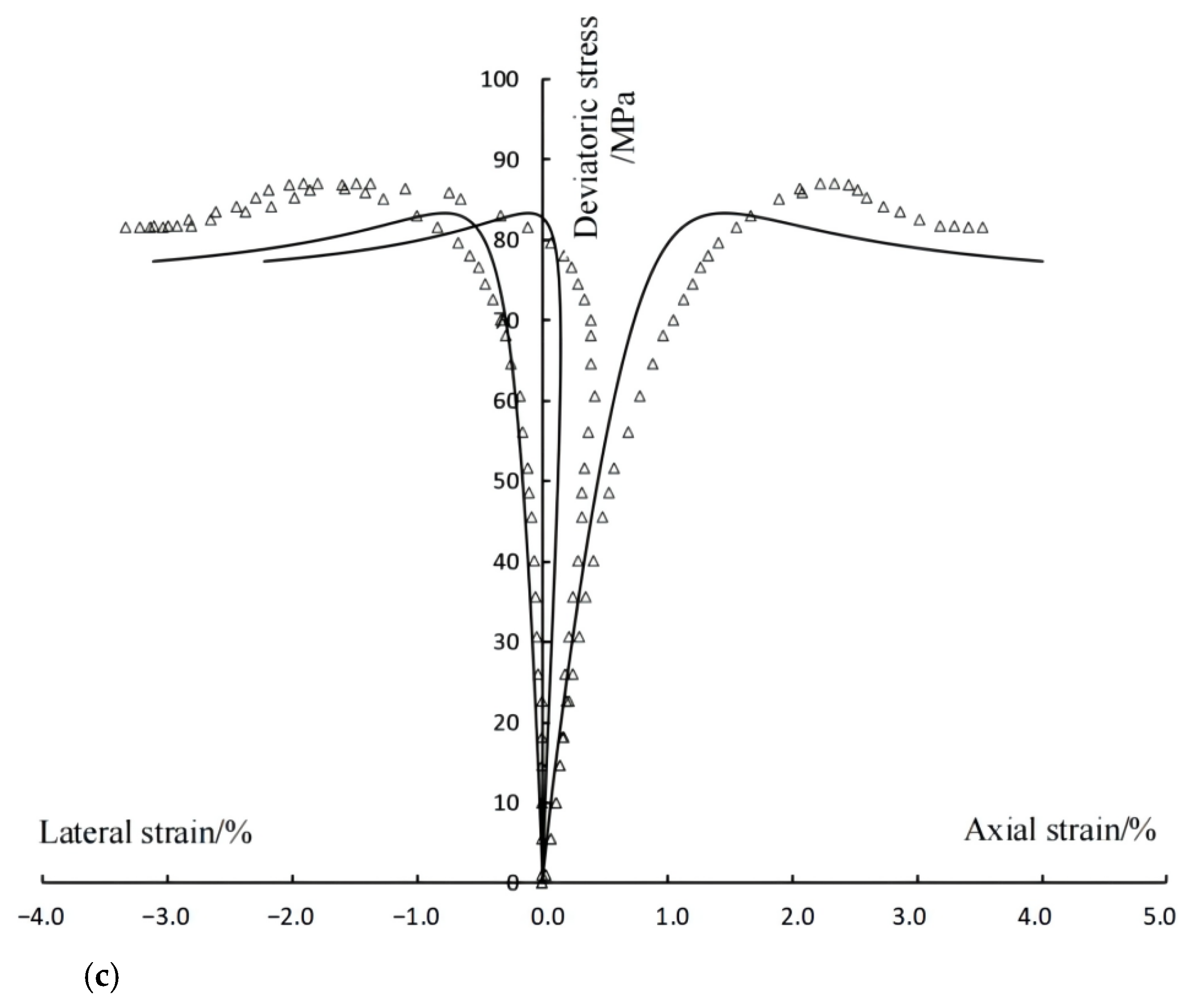
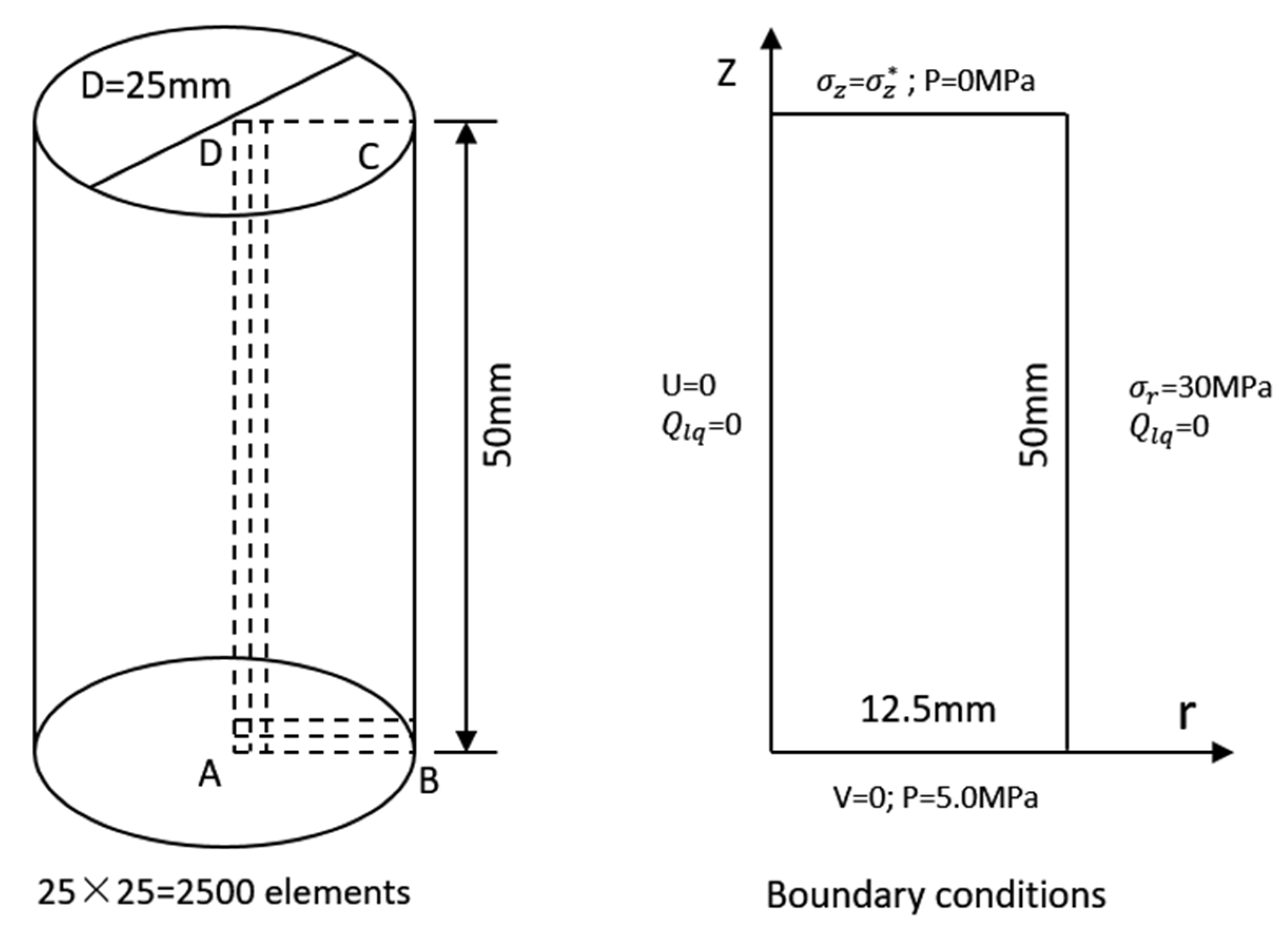
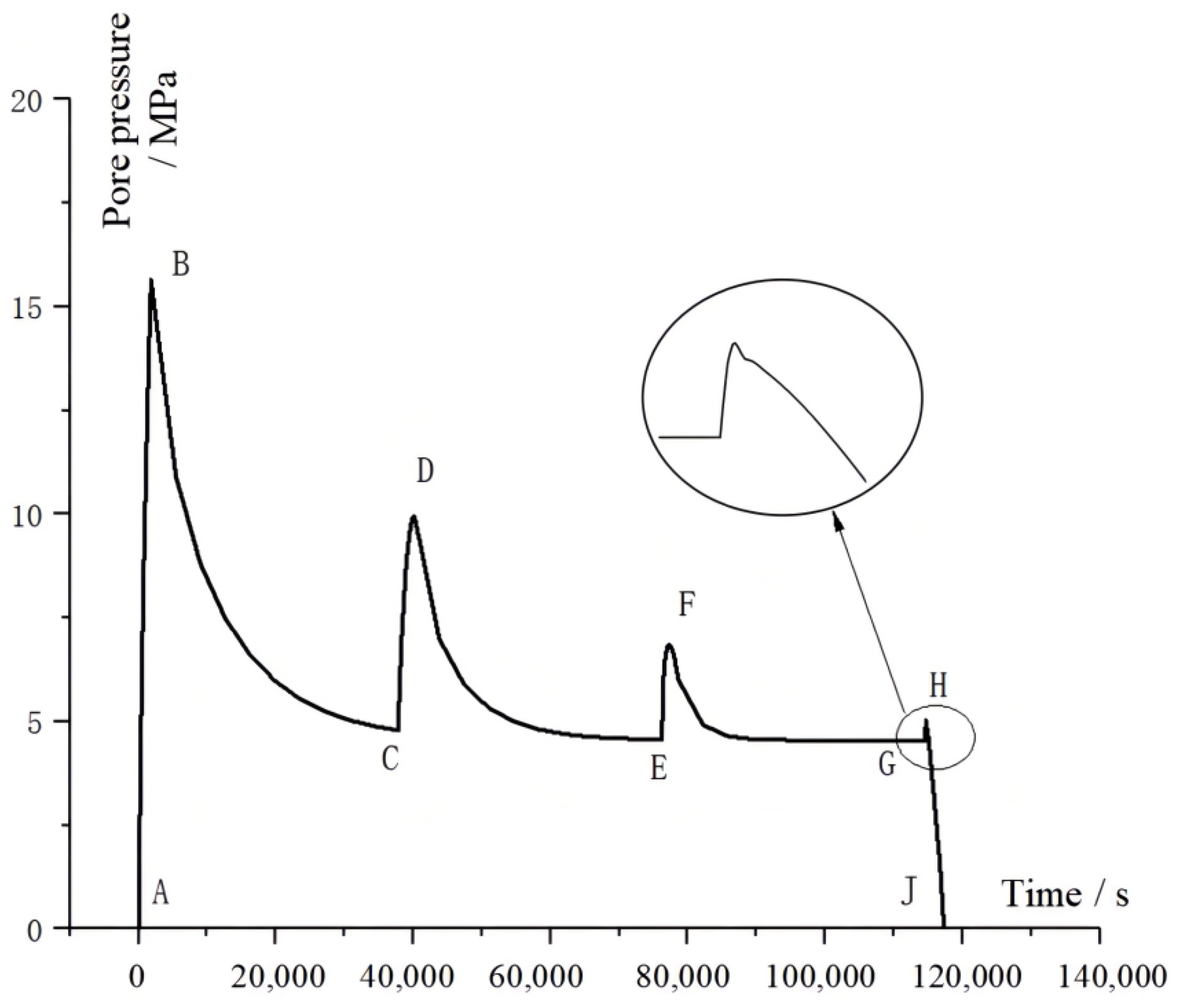
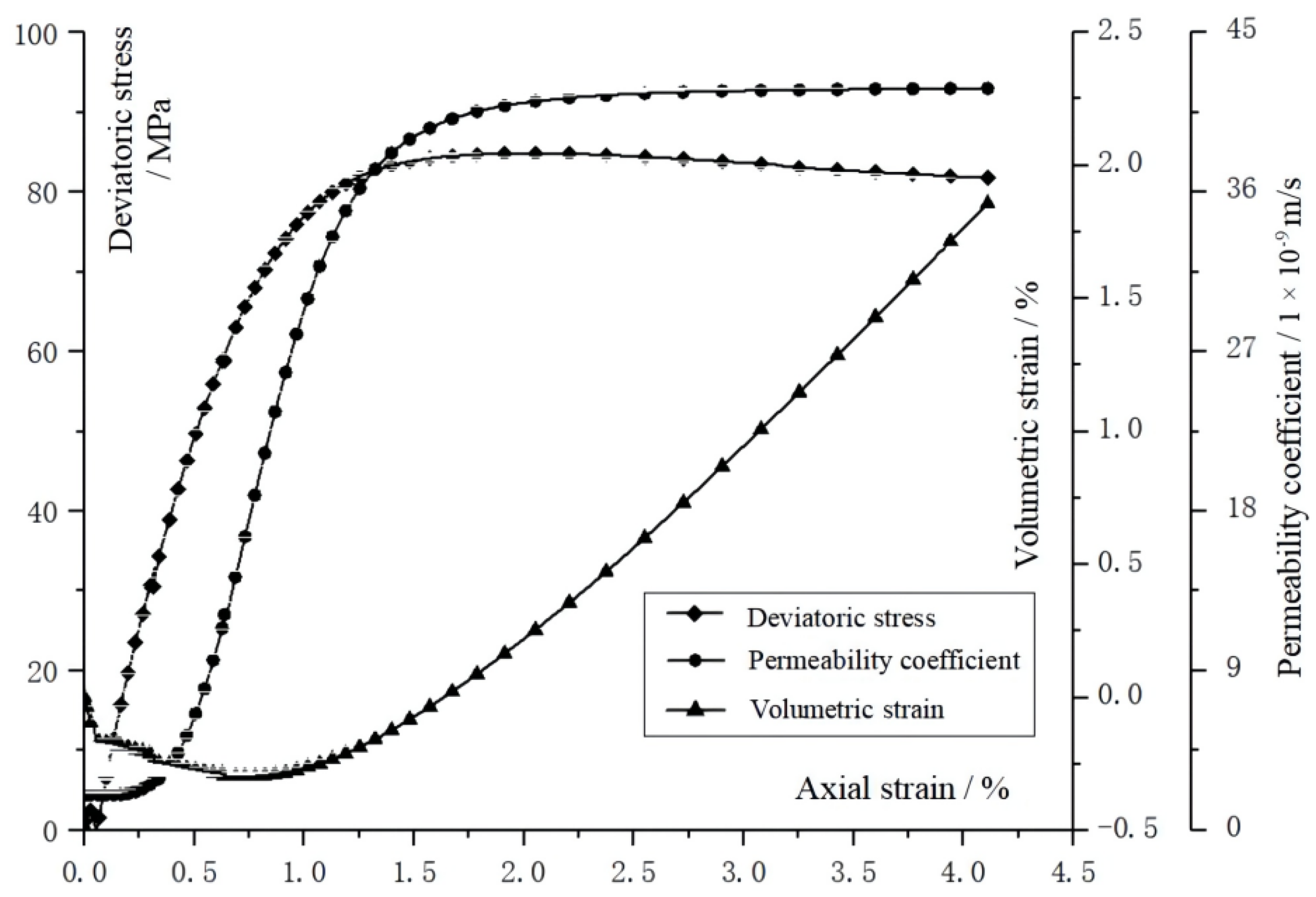
| Confining Pressure /MPa | Elastic Modulus /GPa | Poisson Ratio | Peak Strength /MPa | Residual Strength /MPa |
|---|---|---|---|---|
| 10 | 12.46 | 0.281 | 69.11 | 61.48 |
| 20 | 13.78 | 0.383 | 75.49 | 73.12 |
| 30 | 15.83 | 0.374 | 87.28 | 81.43 |
| Parameter Type | Symbols/Units | Parameter Value |
|---|---|---|
| Elastic parameter | /MPa | 14,020 |
| 0.346 | ||
| Plastic parameter | 180 | |
| /MPa | 13.0 | |
| 0.018 | ||
| b | 0.0025 | |
| η | −0.85 | |
| Damage parameter | m | 2.75 |
Publisher’s Note: MDPI stays neutral with regard to jurisdictional claims in published maps and institutional affiliations. |
© 2022 by the authors. Licensee MDPI, Basel, Switzerland. This article is an open access article distributed under the terms and conditions of the Creative Commons Attribution (CC BY) license (https://creativecommons.org/licenses/by/4.0/).
Share and Cite
Jing, W.; Mei, S.; Zhao, Y.; Zhang, Y. Study on Elastoplastic Damage Coupling of Reservoir Mudstone Considering Permeability Change. Sustainability 2022, 14, 13507. https://doi.org/10.3390/su142013507
Jing W, Mei S, Zhao Y, Zhang Y. Study on Elastoplastic Damage Coupling of Reservoir Mudstone Considering Permeability Change. Sustainability. 2022; 14(20):13507. https://doi.org/10.3390/su142013507
Chicago/Turabian StyleJing, Wenjun, Songhua Mei, Yanan Zhao, and Yu Zhang. 2022. "Study on Elastoplastic Damage Coupling of Reservoir Mudstone Considering Permeability Change" Sustainability 14, no. 20: 13507. https://doi.org/10.3390/su142013507





